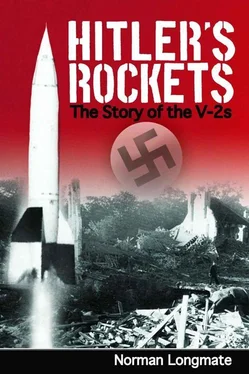For professional reasons, too, Dornberger was eager to produce a missile of sensational range and power:
I had been a heavy gunner. Gunnery’s highest achievement to date had been the huge Paris Gun during the First World War. It could fire a 21 cm [8.2 in] shell with about 25 lb [11.5 kg] of explosive about 80 miles. My idea of a first big rocket was something that would send a ton of high explosive over 160 miles… double the range of the Paris Gun.
Already by the spring of 1936 the main features of the real objective of the research team, an operational rocket soon to be known as the A-4, were emerging. Dornberger constantly reminded his colleagues that they were not engaged in a search for knowledge for its own sake, pioneering though their work was, but in producing a practical weapon in the foreseeable future. One essential was accuracy:
I stipulated a number of military requirements, among others that… for every 1000 feet of range a deviation of only 2 or 3 feet was acceptable, either too far or too short, and the same for lateral deviation… stricter than is customary for artillery.
Another need was mobility:
I limited the size of the rocket by insisting that we must be able to transport it intact by road and that it must not exceed the maximum width laid down for road vehicles. If carried by rail the rocket must be able to pass through any tunnel. These points determined the main dimensions, although we were all certain from the start that a slender body would involve less air resistance and give us greater range. It would be for the engineers to find the ideal flying shape.
Because of the lack of knowledge about how such a large object would behave at supersonic speeds, Dornberger and von Braun decided that they needed their own wind tunnel, and a far larger one than any so far built; up to now they had made do by borrowing the tunnel belonging to the Technical High School at Aachen. Even their most loyal supporter, Karl Becker of the Army Weapons Office, ‘looked grave’ when asked to find an estimated 300,000 additional marks (£26,500) but eventually agreed provided another of the twelve departments within the Army Research and Development Branch would share the cost. Dornberger tried them all and struck lucky with the very last. Soon the huge wind tunnel, ‘expected to be the most efficient in the world’, was adding its shape to the hitherto unspoiled skyline of Usedom.
The team now needed a wind-tunnel specialist and successfully ‘poached’ the academic who had helped them at Aachen. They also recruited the leading authority on rocket motors, Dr Walter Thiel, who had formerly had a desk job at Research Branch headquarters and now moved to a test bench at Kummersdorf. Thiel, although ‘extremely hard-working, conscientious and systematic… was’, admitted Dornberger, ‘tremendously ambitious and aware of his own worth. He took a superior attitude and demanded equal devotion from his colleagues. I had to smooth over a good deal of friction’. However, this proved a price worth paying, for this prima donna of the laboratories soon began to make a major contribution, including one immediate advance, ‘the use of welded sheet-steel chambers’ for the rocket motor instead of the light alloys previously considered indispensable.
Another valuable recruit, Dr Steinhoff, was spotted by von Braun at a conference and invited to visit Peenemünde, where, von Braun correctly anticipated, he would be captivated ‘by the big-scale modern plant, the freedom to work, and the prospects of the rocket’. Dornberger found him wandering about Test Stand I, and was astonished when this ‘young man, apparently in his late twenties… seized my hands with every appearance of genuine enthusiasm and exclaimed “Sir, you must take me! I’m all yours! I want to stay!” ’ Stay he did, not merely abandoning the academic post he was about to take up but drawing ‘a whole train of skilled scientists after him’.
By May 1937 work on Peenemünde was sufficiently far advanced for most of Dornberger’s team, now totalling nearly a hundred, to move there, though Dr Thiel and five of his assistants did not follow them until the summer of 1940. Ultimately Peenemünde was to cost the German taxpayer between £25 and £40 million, but little of this had yet been spent and conditions were still primitive when it was decided to test the first completed A-3 at the new test centre on Greifswalder Oie, the tiny island, five miles from Usedom and seven and a half from the nearest town, Rügen, which Dornberger had identified on his first visit as ideal for the purpose. A mere 1100 yards long by 300 wide, ‘with a steep, loamy coast, lashed by storm and surf in winter’, and standing only 60 feet above the surrounding waves, Greifswalder Oie in 1937 contained only a handful of houses, a lighthouse, linked to the main settlement by a single rough road, and an inn, presided over by an innkeeper of ‘inexhaustible good humour’, which doubtless increased still further as the island became ‘like a swarming anthill’, producing a sensational increase in his trade.
Dornberger was fully conscious of the drama which surrounded the successive tests of the rockets. For none were preparations more elaborate than for this first trial of the A-3 for all the facilities had to be brought by sea to this remote islet and the test stand had to be constructed under conditions more appropriate to the front line than to a sophisticated scientific research project. Dornberger’s sharp eye noted, and recorded in loving detail, each new arrival in the ‘tiny fishing harbour on the south-west coast’ of Greifswalder Oie:
One day a number of small motor launches filled with building personnel and surveyors… arrived in the little harbour. Next came a large vessel of unusual appearance, such as had never been seen before in that part of the Baltic. She carried building materials and… had been a car and passenger ferry…. A typical example of mid-nineteenth-century shipbuilding, she possessed large cabins with decrepit furniture upholstered in red plush, a quantity of gleaming brass fittings and mountings, towering upper works and a high funnel…. The next to arrive were the harbour dredgers and barges.
All this was only the start of months of frenzied activity:
A bustle now began with which the island was wholly unfamiliar. The harbour was dredged. Berths and landing facilities had to be created for big vessels and heavy cargoes. The cart track to the uplands was given a firm surface of planks. In front of the storm-topped coppice that stood to the east of the track a square concrete platform went up. A pit was excavated opposite to it, at the edge of the forest, and a dug-out was built.
The builders and builders’ labourers departed. Engineers and craftsmen took their place. Then came more builders. Lines and cable after cable were laid between the shelter and the central point of the platform. Dug-out, lighthouse and inn were connected by telephone. The dug-out was transformed into an observation post with lookout slits and gauges of all descriptions on the walls…. In the coppice immediately behind the shelter two big open clearings were made and levelled off…. Generators were unloaded at the harbour and brought to the coppice. Wiring was laid for electric light. Petrol, materials and tools arrived by sea. Weeks passed in a whirl of activity.
It was a red-letter day when the rockets themselves arrived:
One day at the end of November the ferry-boat delivered two large boxes painted dark grey. They were 21 feet long and 4½ feet in depth and breadth. These giants’ coffins were unloaded with great care and cautiously conveyed in a heavy lorry to the tent. There they were guarded day and night. Shortly afterwards two further chests of this type were unloaded and taken into the tent.
Читать дальше






![Traudl Junge - Hitler's Last Secretary - A Firsthand Account of Life with Hitler [aka Until the Final Hour]](/books/416681/traudl-junge-hitler-s-last-secretary-a-firsthand-thumb.webp)





